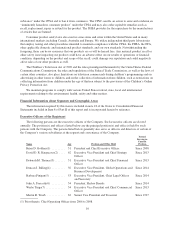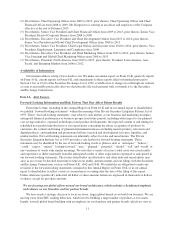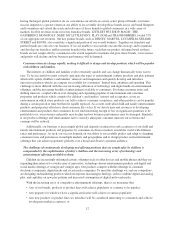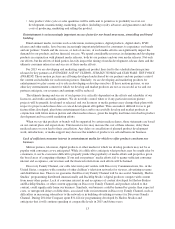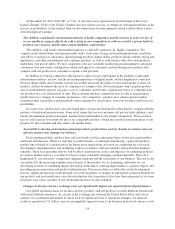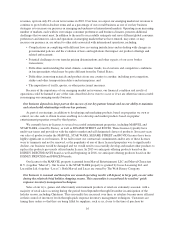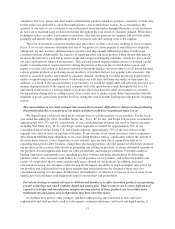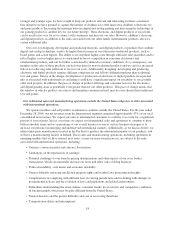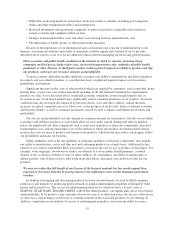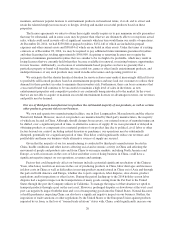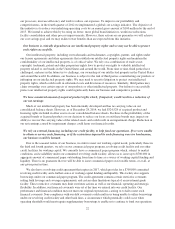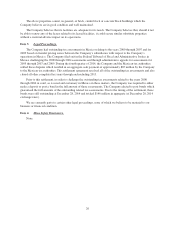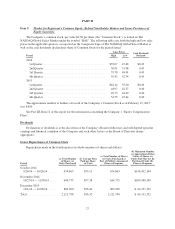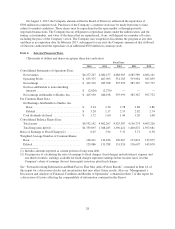Hasbro 2014 Annual Report Download - page 32
Download and view the complete annual report
Please find page 32 of the 2014 Hasbro annual report below. You can navigate through the pages in the report by either clicking on the pages listed below, or by using the keyword search tool below to find specific information within the annual report.younger and younger ages, we have sought to keep our products relevant and interesting for these consumers.
One initiative we have pursued to capture the interest of children is to offer innovative children’s electronic toy
and game products. Increasing the marriage between digital and analog gaming and increasing the technology in
our gaming products is another key for our future strategy. These electronic and digital products, if successful,
can be an effective way for us to connect with consumers and increase our sales. However, children’s electronic
and digital products, in addition to the risks associated with our other family entertainment products, also face
certain additional risks.
Our costs for designing, developing and producing electronic and digital products, or products that combine
digital and analog technology, tend to be higher than for many of our other more traditional products, such as
board games and action figures. The ability to recoup these higher costs through sufficient sales quantities and to
reflect higher costs in higher prices is constrained by heavy competition in consumer electronics and
entertainment products, and can be further constrained by difficult economic conditions. As a consequence, our
margins on the sales of these products can be lower than for more traditional products and we can face increased
risk of not achieving sales sufficient to recover our costs. Additionally, designing, developing and producing
electronic and digital products requires different competencies and follows different timelines than traditional
toys and games. Delays in the design, development or production of electronic or digital products incorporated
into or associated with traditional toys and games could have a significant impact on our ability to successfully
offer such projects. In addition, the pace of change in product offerings and consumer tastes in the electronics
and digital gaming areas is potentially even greater than for our other products. This pace of change means that
the window in which a product can achieve and maintain consumer interest may be even shorter than traditional
toys and games.
Our substantial sales and manufacturing operations outside the United States subject us to risks associated
with international operations.
We operate facilities and sell products in numerous countries outside the United States. For the year ended
December 28, 2014, our net revenues from the International segment comprised approximately 47% of our total
consolidated net revenues. We expect our sales to international customers to continue to account for a significant
portion of our revenues. In fact, over time, we expect our international sales and operations to continue to grow
both in absolute terms and as a percentage of our overall business as one of our key business strategies is to
increase our presence in emerging and underserved international markets. Additionally, as we discuss below, we
utilize third-party manufacturers located in the Far East to produce the substantial majority of our products, and
we have a manufacturing facility in Ireland. These sales and manufacturing operations, including operations in
emerging markets that we have entered, may enter, or may increase our presence in, are subject to the risks
associated with international operations, including:
• Currency conversion risks and currency fluctuations;
• Limitations on the repatriation of earnings;
• Potential challenges to our transfer pricing determinations and other aspects of our cross border
transactions, which can materially increase our taxes and other costs of doing business;
• Political instability, civil unrest and economic instability;
• Greater difficulty enforcing intellectual property rights and weaker laws protecting such rights;
• Complications in complying with different laws in varying jurisdictions and in dealing with changes in
governmental policies and the evolution of laws and regulations and related enforcement;
• Difficulties understanding the retail climate, consumer trends, local customs and competitive conditions
in foreign markets which may be quite different from the United States;
• Natural disasters and the greater difficulty and cost in recovering therefrom;
• Transportation delays and interruptions;
18




